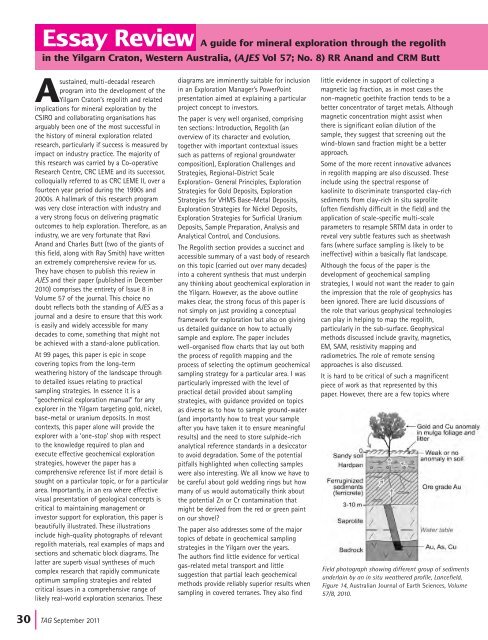TAG - Geological Society of Australia
TAG - Geological Society of Australia
TAG - Geological Society of Australia
You also want an ePaper? Increase the reach of your titles
YUMPU automatically turns print PDFs into web optimized ePapers that Google loves.
Essay Review A guide for mineral exploration through the regolithin the Yilgarn Craton, Western <strong>Australia</strong>, (AJES Vol 57; No. 8) RR Anand and CRM Butt30 |Asustained, multi-decadal researchprogram into the development <strong>of</strong> theYilgarn Craton’s regolith and relatedimplications for mineral exploration by theCSIRO and collaborating organisations hasarguably been one <strong>of</strong> the most successful inthe history <strong>of</strong> mineral exploration relatedresearch, particularly if success is measured byimpact on industry practice. The majority <strong>of</strong>this research was carried by a Co-operativeResearch Centre, CRC LEME and its successor,colloquially referred to as CRC LEME II, over afourteen year period during the 1990s and2000s. A hallmark <strong>of</strong> this research programwas very close interaction with industry anda very strong focus on delivering pragmaticoutcomes to help exploration. Therefore, as anindustry, we are very fortunate that RaviAnand and Charles Butt (two <strong>of</strong> the giants <strong>of</strong>this field, along with Ray Smith) have writtenan extremely comprehensive review for us.They have chosen to publish this review inAJES and their paper (published in December2010) comprises the entirety <strong>of</strong> Issue 8 inVolume 57 <strong>of</strong> the journal. This choice nodoubt reflects both the standing <strong>of</strong> AJES as ajournal and a desire to ensure that this workis easily and widely accessible for manydecades to come, something that might notbe achieved with a stand-alone publication.At 99 pages, this paper is epic in scopecovering topics from the long-termweathering history <strong>of</strong> the landscape throughto detailed issues relating to practicalsampling strategies. In essence it is a“geochemical exploration manual” for anyexplorer in the Yilgarn targeting gold, nickel,base-metal or uranium deposits. In mostcontexts, this paper alone will provide theexplorer with a ‘one-stop’ shop with respectto the knowledge required to plan andexecute effective geochemical explorationstrategies, however the paper has acomprehensive reference list if more detail issought on a particular topic, or for a particulararea. Importantly, in an era where effectivevisual presentation <strong>of</strong> geological concepts iscritical to maintaining management orinvestor support for exploration, this paper isbeautifully illustrated. These illustrationsinclude high-quality photographs <strong>of</strong> relevantregolith materials, real examples <strong>of</strong> maps andsections and schematic block diagrams. Thelatter are superb visual syntheses <strong>of</strong> muchcomplex research that rapidly communicateoptimum sampling strategies and relatedcritical issues in a comprehensive range <strong>of</strong>likely real-world exploration scenarios. These<strong>TAG</strong> September 2011diagrams are imminently suitable for inclusionin an Exploration Manager’s PowerPointpresentation aimed at explaining a particularproject concept to investors.The paper is very well organised, comprisingten sections: Introduction, Regolith (anoverview <strong>of</strong> its character and evolution,together with important contextual issuessuch as patterns <strong>of</strong> regional groundwatercomposition), Exploration Challenges andStrategies, Regional-District ScaleExploration- General Principles, ExplorationStrategies for Gold Deposits, ExplorationStrategies for VHMS Base-Metal Deposits,Exploration Strategies for Nickel Deposits,Exploration Strategies for Surficial UraniumDeposits, Sample Preparation, Analysis andAnalytical Control, and Conclusions.The Regolith section provides a succinct andaccessible summary <strong>of</strong> a vast body <strong>of</strong> researchon this topic (carried out over many decades)into a coherent synthesis that must underpinany thinking about geochemical exploration inthe Yilgarn. However, as the above outlinemakes clear, the strong focus <strong>of</strong> this paper isnot simply on just providing a conceptualframework for exploration but also on givingus detailed guidance on how to actuallysample and explore. The paper includeswell-organised flow charts that lay out boththe process <strong>of</strong> regolith mapping and theprocess <strong>of</strong> selecting the optimum geochemicalsampling strategy for a particular area. I wasparticularly impressed with the level <strong>of</strong>practical detail provided about samplingstrategies, with guidance provided on topicsas diverse as to how to sample ground-water(and importantly how to treat your sampleafter you have taken it to ensure meaningfulresults) and the need to store sulphide-richanalytical reference standards in a desiccatorto avoid degradation. Some <strong>of</strong> the potentialpitfalls highlighted when collecting sampleswere also interesting. We all know we have tobe careful about gold wedding rings but howmany <strong>of</strong> us would automatically think aboutthe potential Zn or Cr contamination thatmight be derived from the red or green painton our shovel?The paper also addresses some <strong>of</strong> the majortopics <strong>of</strong> debate in geochemical samplingstrategies in the Yilgarn over the years.The authors find little evidence for verticalgas-related metal transport and littlesuggestion that partial leach geochemicalmethods provide reliably superior results whensampling in covered terranes. They also findlittle evidence in support <strong>of</strong> collecting amagnetic lag fraction, as in most cases thenon-magnetic goethite fraction tends to be abetter concentrator <strong>of</strong> target metals. Althoughmagnetic concentration might assist whenthere is significant eolian dilution <strong>of</strong> thesample, they suggest that screening out thewind-blown sand fraction might be a betterapproach.Some <strong>of</strong> the more recent innovative advancesin regolith mapping are also discussed. Theseinclude using the spectral response <strong>of</strong>kaolinite to discriminate transported clay-richsediments from clay-rich in situ saprolite(<strong>of</strong>ten fiendishly difficult in the field) and theapplication <strong>of</strong> scale-specific multi-scaleparameters to resample SRTM data in order toreveal very subtle features such as sheetwashfans (where surface sampling is likely to beineffective) within a basically flat landscape.Although the focus <strong>of</strong> the paper is thedevelopment <strong>of</strong> geochemical samplingstrategies, I would not want the reader to gainthe impression that the role <strong>of</strong> geophysics hasbeen ignored. There are lucid discussions <strong>of</strong>the role that various geophysical technologiescan play in helping to map the regolith,particularly in the sub-surface. Geophysicalmethods discussed include gravity, magnetics,EM, SAM, resistivity mapping andradiometrics. The role <strong>of</strong> remote sensingapproaches is also discussed.It is hard to be critical <strong>of</strong> such a magnificentpiece <strong>of</strong> work as that represented by thispaper. However, there are a few topics whereField photograph showing different group <strong>of</strong> sedimentsunderlain by an in situ weathered pr<strong>of</strong>ile, Lancefield,Figure 14, <strong>Australia</strong>n Journal <strong>of</strong> Earth Sciences, Volume57/8, 2010.
















